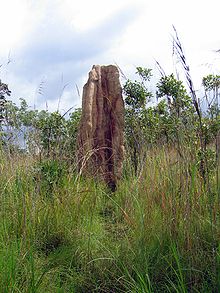- Mound-building termites
-
For other uses of the term "mound builder", see Mound Builder (disambiguation).
 Erecting the original Cape York telegraph line on wooden poles was a mistake, as this series of termite mounds shows.
Erecting the original Cape York telegraph line on wooden poles was a mistake, as this series of termite mounds shows.
Mound-building termites or just mound builders are a group of termite species that live in mounds. This group of termites live in Africa, Australia and South America. The mounds sometimes have a diameter of 30 metres. Most of the mounds are found in well drained areas. Termite mounds usually out live the colonies themselves. If the inner tunnels of the nest are exposed it is usually dead, however, sometimes other colonies occupy a mound after the death of the original builders. The new colonizers may be of the same or a different species.
Mound Structure
The structure of the mounds can be very complicated. Inside the mound is an extensive system of tunnels and conduits that serves as a ventilation system for the underground nest. In order to get good ventilation, the termites will construct several shafts leading down to the cellar located beneath the nest. The mound is built above the subterranean nest. The nest itself is a spheroidal structure consisting of numerous gallery chambers. They come in a wide variety of shapes and sizes. Some, like Odontotermes termites build open chimneys or vent holes into their mounds, while others build completely enclosed mounds like Macrotermes. The Amitermes(Magnetic termites) mounds are created tall, thin, wedge-shaped, usually oriented north-south.
Social Caste
Workers, smallest in size, are the most numerous of the castes. They are all completely blind, wingless, and sexually immature. Their job is to feed and groom all of the dependent castes. They also dig tunnels, locate food and water, maintain colony atmospheric homeostasis, and build and repair the nest.
The soldiers job is to basically defend the colony from any unwanted animals. When the large soldiers attack they emit a drop of brown, corrosive salivary liquid which spreads between the open mandibles. When they bite, the liquid spreads over the opponent. The secretion is commonly stated to be toxic or else undergoes coagulation with the air, which renders it glue-like.
Finally, there are the reproductives. They include the king and the queen. The queen can sometimes grow up to six centimetres long while the lower classes are generally less than one centimetre.
Categories:- Termites
Wikimedia Foundation. 2010.

